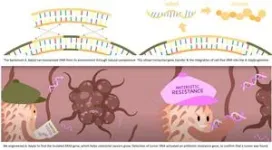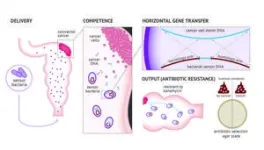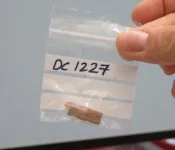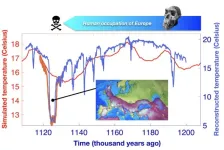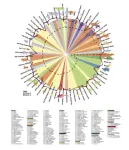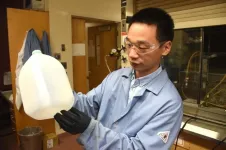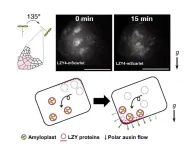(Press-News.org) Pushing into a new chapter of technologically advanced biological sensors, scientists from the University of California San Diego and their colleagues in Australia have engineered bacteria that can detect the presence of tumor DNA in a live organism.
Their innovation, which detected cancer in the colons of mice, could pave the way to new biosensors capable of identifying various infections, cancers and other diseases.
The advancement is described Aug. 11, 2023, in the journal Science. Bacteria previously have been designed to carry out various diagnostic and therapeutic functions, but lacked the ability to identify specific DNA sequences and mutations outside of cells. The new “Cellular Assay for Targeted CRISPR-discriminated Horizontal gene transfer,” or “CATCH,” was designed to do just that.
“As we started on this project four years ago, we weren’t even sure if using bacteria as a sensor for mammalian DNA was even possible,” said scientific team leader Jeff Hasty, a professor in the UC San Diego School of Biological Sciences and Jacobs School of Engineering. “The detection of gastrointestinal cancers and precancerous lesions is an attractive clinical opportunity to apply this invention.”
Tumors are known to disperse, or shed, their DNA into the environments surrounding them. Many technologies can analyze purified DNA in the lab, but these cannot detect DNA where it is released. Under the CATCH strategy, the researchers engineered bacteria using CRISPR technology to test free-floating DNA sequences on a genomic level and compare those samples with predetermined cancer sequences (see video).
“Many bacteria can take up DNA from their environment, a skill known as natural competence,” said Rob Cooper, the study’s co-first author and a scientist at UC San Diego’s Synthetic Biology Institute. Hasty, Cooper and Australian doctor Dan Worthley collaborated on the idea of natural competence in relation to bacteria and colorectal cancer, the third-leading cause of cancer-related death in the United States.
They began to formulate the possibility of engineering bacteria, which are already prevalent in the colon, as new biosensors that could be deployed inside the gut to detect DNA released from colorectal tumors. They focused on Acinetobacter baylyi, a bacterium in which Cooper identified the elements necessary for both taking up DNA and using CRISPR to analyze it.
“Knowing that cell-free DNA can be mobilized as a signal, or an input, we set out to engineer bacteria that would respond to tumor DNA at the time and place of disease detection,” said Worthley, a gastroenterologist and cancer researcher with the Colonoscopy Clinic in Brisbane, Australia.
Working with Australian colleagues Susan Woods and Josephine Wright, the researchers designed, built and tested Acinetobacter baylyi as a sensor for identifying DNA from KRAS, a gene that is mutated in many cancers. They programmed the bacterium with a CRISPR system designed to discriminate mutant from normal (non-mutated) copies of KRAS. This means that only bacteria that had taken up mutant forms of KRAS, as found in precancerous polyps and cancers, for example, would survive to signal or respond to the disease.
The new research is based on previous ideas related to horizontal gene transfer, a technique used by organisms to move genetic material between one another in a manner distinct from traditional parent-to-offspring genetic inheritance. While horizontal gene transfer is widely known from bacteria to bacteria, the researchers achieved their goal of applying this concept from mammalian tumors and human cells into bacteria.
“It was incredible when I saw the bacteria that had taken up the tumor DNA under the microscope. The mice with tumors grew green bacterial colonies that had acquired the ability to grow on antibiotic plates,” said Wright.
The researchers are now adapting their bacteria biosensor strategy with new circuits and different types of bacteria for detecting and treating human cancers and infections.
“There is so much potential to engineer bacteria to prevent colorectal cancer, a tumor that is immersed in a stream of bacteria, that could help, or hinder, its progression,” said Woods.
Associate Professor Siddhartha Mukherjee of Columbia University, who was not involved in the study, indicated that in the future, “disease will be treated and prevented by cells, not pills. A living bacterium that can detect DNA in the gut is a tremendous opportunity to act as a sentinel to seek and destroy gastrointestinal, and many other, cancers.”
While the new invention requires further development and refinement, the synthetic biology team at UC San Diego continues to optimize the advanced biosensor strategy, said Hasty, who holds affiliations with UC San Diego’s Department of Molecular Biology, Shu Chien-Gene Lay Department of Bioengineering and Synthetic Biology Institute.
“There’s a future where nobody need die of colorectal cancer,” believes Worthley. “We hope that this work will be useful to bioengineers, scientists and, in the future, clinicians, in pursuit of this goal.”
The coauthors of the Science paper are: Robert Cooper, Josephine Wright, Jia Ng, Jarrad Goyne, Nobumi Suzuki, Young Lee, Mari Ichinose, Georgette Radford, Feargal Ryan, Shalni Kumar, Elaine Thomas, Laura Vrbanac, Rob Knight, Susan Woods, Daniel Worthley and Jeff Hasty.
END
Researchers engineer bacteria that can detect tumor DNA
Advanced biosensor leverages CRISPR to identify colon cancer
2023-08-10
ELSE PRESS RELEASES FROM THIS DATE:
Climate modeling reveals new insights into hominin migration and evolution
2023-08-10
In two studies, researchers demonstrate how climate modeling approaches can fill gaps in our understanding of hominin evolution and migration.
Over the last several decades, research efforts into the lives of hominins – humans and their close ancestors – have shifted from identifying fossils and artifacts to understanding the environmental and climate settings in which they lived and how these factors could have influenced hominin evolution and migration. However, like the hominin fossil record, environmental and climate records that accurately capture environmental change and span the period over which ...
New approaches enable chemical upcycling of polyethylene and polypropylene plastics
2023-08-10
In two studies, researchers present new ways to convert common waste plastics, polyethylene (PE) and polypropylene (PP), into high-value chemical products, including alcohols, aldehydes, surfactants, and detergents. The approaches provide a pathway toward creating a circular plastics economy and the ability to produce high-value chemicals more sustainably. Waste plastics are increasingly being considered a potentially abundant source of feedstock to produce valuable chemical compounds. However, some plastics, particularly polyolefin plastics like PE and PP – widely used commodity plastics that account ...
Special Issue: Australia
2023-08-10
In this Special Issue of Science, three Reviews, a Policy Forum, and a Perspective highlight Australia’s exceptional exposure to the risks of climate change and ecosystem degradation. Australia is home to Earth’s most ancient ecosystems and oldest continuous indigenous cultures, which have survived for more than 60,000 years. However, the continent’s unique ecosystems and cultural history have proved vulnerable to waves of European colonization and its associated social and environmental impacts. Ongoing climate change and the ...
Global ecosystem water use efficiency has stalled since 2001
2023-08-10
Increases in global ecosystem water use efficiency – the ratio between carbon assimilation to water evapotranspiration – have stalled since 2001 due to a rising vapor pressure deficit, according to a new study. The findings highlight one way that the adverse effects of our warming climate may undermine human reliance on nature-based climate solutions to achieve carbon neutrality. The rapid rise of atmospheric carbon dioxide (CO2) has led to substantial changes in global terrestrial carbon and water cycles. One of these impacts has been a generalized increase in ecosystem water use efficiency (WUEeco). On a global scale, WUEeco plays ...
A climate-orchestrated early human love story
2023-08-10
A new study published in the journal Science by an international team finds that past changes in atmospheric CO2 and corresponding shifts in climate and vegetation played a key role in determining when and where early human species interbred.
Modern-day people carry in their cells a small quantity of DNA deriving from other human species, namely the Neanderthals and the elusive Denisovans. Back in 2018, scientists announced to the world the discovery of an individual [Figure 1], later nicknamed Denny, who lived 90,000 years ago and who was identified as a daughter to a Denisovan father and a Neanderthal mother [Slon et al. 2018]. Denny, along with fellow mixed-ancestry ...
How a massive North Atlantic cooling event disrupted early human occupation in Europe
2023-08-10
A new study published in the journal Science finds that around 1.12 million years ago a massive cooling event in the North Atlantic and corresponding shifts in climate, vegetation and food resources disrupted early human occupation of Europe.
The study published by an international group of scientists from the UK, South Korea and Spain presents observational and modelling evidence documenting that unprecedented climate stress changed the course of early human history.
Archaic humans, known as Homo erectus moved from Africa into central Eurasia around 1.8 million years. From there on they spread towards western Europe, reaching the Iberian peninsula around 1.5 million ...
Global consortium creates large-scale, cross-species database and universal ‘clock’ to estimate age in all mammalian tissues
2023-08-10
Scientists at UCLA David Geffen School of Medicine and UCLA Health led an international research team that published two articles detailing changes in DNA – changes that researchers found are shared by humans and other mammals throughout history and are associated with life span and numerous other traits.
“We've discovered that the life spans of mammals are closely associated with chemical modifications of the DNA molecule, specifically known as epigenetics, or more accurately, methylation. In essence, mammals with longer life spans exhibit more pronounced DNA methylation landscapes, whereas those ...
Extreme cooling ended the first human occupation of Europe
2023-08-10
Paleoclimate evidence shows that around 1.1 million years ago, the southern European climate cooled significantly and likely caused an extinction of early humans on the continent, according to a new study led by UCL researchers.
Published in the journal Science, the team of researchers discovered the occurrence of previously unknown extreme glacial conditions around 1.1 million years ago. The glacial cooling pushed the European climate to levels beyond what archaic humans could tolerate, emptying the continent of human populations.
The oldest known human remains in ...
An unexpected way to upcycle: Plastic waste transforms into soap
2023-08-10
A team led by Virginia Tech researchers has developed a new method for upcycling plastics into high-value chemicals known as surfactants, which are used to create soap, detergent, and more.
Plastics and soaps tend to have little in common when it comes to texture, appearance, and, most importantly, how they are used. But there is a surprising connection between the two on a molecular level: The chemical structure of polyethylene — one of the most commonly used plastics in the world today — is strikingly similar ...
The positional transmitter of statoliths unveiled: It keeps plants from getting lazy
2023-08-10
Plants orient their organs in response to the gravity vector, with roots growing towards gravity and shoots growing in the opposite direction. The movement of statoliths responding to the inclination relative to the gravity vector is employed for gravity sensing in both plants and animals. However, in plants, the statolith takes the form of a high-density organelle, known as an amyloplast, which settles toward gravity within the gravity sensing cell. Despite the significance of this gravity sensing mechanism, the exact process behind it has eluded scientists ...
LAST 30 PRESS RELEASES:
Making lighter work of calculating fluid and heat flow
Normalizing blood sugar can halve heart attack risk
Lowering blood sugar cuts heart attack risk in people with prediabetes
Study links genetic variants to risk of blinding eye disease in premature infants
Non-opioid ‘pain sponge’ therapy halts cartilage degeneration and relieves chronic pain
AI can pick up cultural values by mimicking how kids learn
China’s ecological redlines offer fast track to 30 x 30 global conservation goal
Invisible indoor threats: emerging household contaminants and their growing risks to human health
Adding antibody treatment to chemo boosts outcomes for children with rare cancer
Germline pathogenic variants among women without a history of breast cancer
Tanning beds triple melanoma risk, potentially causing broad DNA damage
Unique bond identified as key to viral infection speed
Indoor tanning makes youthful skin much older on a genetic level
Mouse model sheds new light on the causes and potential solutions to human GI problems linked to muscular dystrophy
The Journal of Nuclear Medicine ahead-of-print tip sheet: December 12, 2025
Smarter tools for peering into the microscopic world
Applications open for funding to conduct research in the Kinsey Institute archives
Global measure underestimates the severity of food insecurity
Child survivors of critical illness are missing out on timely follow up care
Risk-based vs annual breast cancer screening / the WISDOM randomized clinical trial
University of Toronto launches Electric Vehicle Innovation Ontario to accelerate advanced EV technologies and build Canada’s innovation advantage
Early relapse predicts poor outcomes in aggressive blood cancer
American College of Lifestyle Medicine applauds two CMS models aligned with lifestyle medicine practice and reimbursement
Clinical trial finds cannabis use not a barrier to quitting nicotine vaping
Supplemental nutrition assistance program policies and food insecurity
Switching immune cells to “night mode” could limit damage after a heart attack, study suggests
URI-based Global RIghts Project report spotlights continued troubling trends in worldwide inhumane treatment
Neutrophils are less aggressive at night, explaining why nighttime heart attacks cause less damage than daytime events
Menopausal hormone therapy may not pose breast cancer risk for women with BRCA mutations
Mobile health tool may improve quality of life for adolescent and young adult breast cancer survivors
[Press-News.org] Researchers engineer bacteria that can detect tumor DNAAdvanced biosensor leverages CRISPR to identify colon cancer

